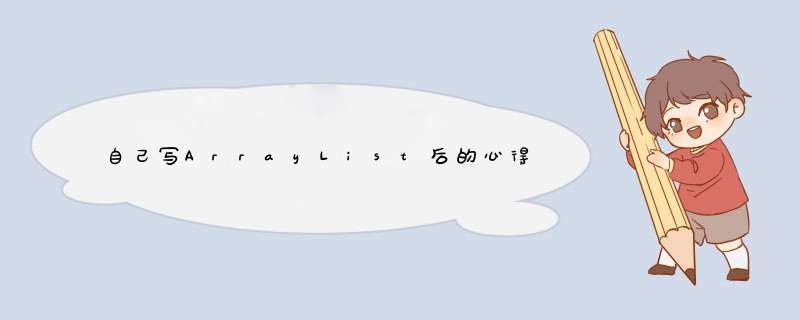
ArrayList应该是Java工具类中最简单的一个。它的内部实现是一个数组,在首次加入元素时,ArrayList会创建一个默认大小的数组,之后的添加、删除、查询 *** 作都是对该数组进行 *** 作。而我自己写的ArrayList则是和LinkedList一样,基于链表实现。下面会一一比较两种方法的差别。
add方法ArrayList源码的:
public void add(int index, E element) {
//检查索引是否越界
rangeCheckForAdd(index);
ensureCapacityInternal(size + 1);
//索引之后的元素向后自动移动一位
System.arraycopy(elementData, index, elementData, index + 1,size - index);
//将指定元素赋值
elementData[index] = element;
size++;
}
我的add方法:
public void add(int index, Object obj) {
//检查index是否越界
if(index > size || index < 0) {
return;
}
if(index == size) {
this.add(obj);
return;
}
Node node = new Node(obj, null, null);
Node temp;
//如果插入的是头部
if(index == 0) {
temp = this.tail;
temp.next = node;
node.previous = temp;
}
//其它地方
else {
Node insert = indexOf(index);
Node previous = insert.previous;
node.previous = previous;
node.next = insert; // 要注意此时的节点为inset
previous.next = node;
insert.previous = node;
}
size++;
}
不难看出,用链表的话我们每次都需要判断插入位置,因为头部之前没有链表了,即head没有东西。但也有好处:无需利用ArrayCopy将引索之后的元素移位。这里就体现出来了数组增加速度慢,代价大。
remove方法ArrayList的:
public E remove(int index) {
//检查索引值
rangeCheck(index);
modCount++;
E oldValue = elementData(index);
int numMoved = size - index - 1;
if (numMoved > 0)
//删除的元素后还有元素,则将后面的元素往前移一位
System.arraycopy(elementData, index+1, elementData, index,numMoved);
elementData[--size] = null; // clear to let GC do its work
return oldValue;
}
我的:
public void remove(int index) {
Node n;
//移除的是第一个
if (index == 0)
{
n = head.next;
head = n;
n.previous = null;
} else if (index == size - 1) { // 移除的的是最后一个
n = tail.previous;
tail = n;
n.next = null;
} else {
Node node = indexOf(index);
Node previous = node.previous;
Node next = node.next;
previous.next = next;
next.previous = previous;
}
size--;
}
和add一样,用链表直接删除对应的节点就行,效率高(但我感觉好像差不多)。
clear方法ArrayList的:
public void clear() {
modCount++;
// clear to let GC do its work
for (int i = 0; i < size; i++)
elementData[i] = null;
size = 0;
}
我的:
public void clear() { // 清除让所有节点置空即
this.head = null;
this.tail = null;
size = 0;
}
如果用数组,需要将数组中每一个元素置空,而如果用链表直接将head头节点和tail尾节点置空即可。
从上面几个方法我们不难看出链表的优势:增加、删除速度快,代价小,效率高。
当然用链表时我也遇到了一些问题,譬如get()方法。用链表写最后的返回值是所查元素的地址而不是你需要的元素。这里也体现出来了链表节点的组成特点:存储下一个结点的地址。以及相较于数组链表失去了数组随机读取的优点。
欢迎分享,转载请注明来源:内存溢出

 微信扫一扫
微信扫一扫
 支付宝扫一扫
支付宝扫一扫
评论列表(0条)